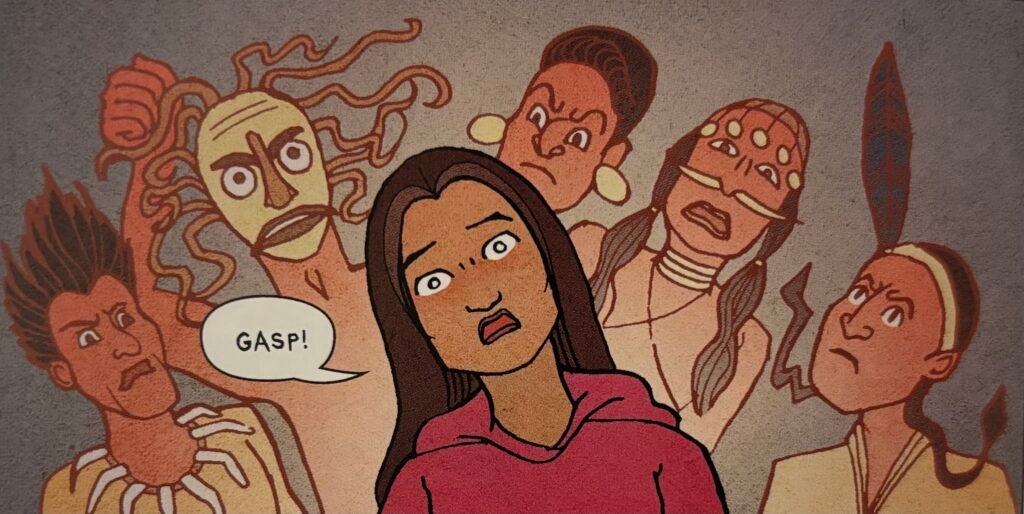“Two Tribes” by Emily Bowen Cohen

written by Stella Fried
I came across “Two Tribes” quite by accident. I was straightening up the shelves in the children’s graphic novel section when I noticed a book with a girl wearing a Star of David necklace and a Muscogee beaded necklace on the cover. I was immediately intrigued. Jewish and Native American is not a combination usually seen. I knew I had to take “Two Tribes” home and read it.
After moving to California with her Jewish mother and stepfather, Mia is still adapting to the new focus her Jewish identity takes in her life. Even though Mia had her Bat Mitzvah, she still feels out of place in her Jewish school, where she’s one of the only non-white and definitely the only Native American student. Without telling her mother, Mia decides to use her Bat Mitzvah money to go visit her father and the rest of her Native American family, where she realizes the connections between the two parts of her identity.
Reading Bowen Cohen’s bio on the back cover, it’s clear this story comes from personal experience. Bowen Cohen grew up with a Native American father and Jewish mother, and at a young age she too lost connection with that part of her identity. Now, Bowen Cohen is married to a Jewish man, and they are raising their three kids to feel a connection to both their Jewish and Native parts.
At first, when we see Mia complain about having to learn Hebrew, my instinct was to be annoyed and wonder why Mia isn’t more open to her Jewish side. But then I realized how biased that thought was. Why was I so focused on taking away Mia’s intersectionality? How would I feel if I was suddenly forced to learn a language or be part of a religion that I felt no connection to? I’d certainly feel the same way Mia did. Letting go of that knee-jerk feeling allowed me to fully immerse myself in the story and watch Mia’s journey it the intersection of her Native American and Jewish identities.
Bowen Cohen does a phenomenal job of helping the reader understand and connect with Mia. Even though I initially felt hurt that Mia seemed to be rejecting her Jewishness, I quickly saw why Mia felt the way that she did. Mia’s mother didn’t want to talk about Mia’s father at all. In fact, Mia seemed to spend more time talking about him with her stepfather and she did with her mother. If my mother wanted so little to do with my other parent, to the point where even talking about traditions, whether they were cultural, religious, or familial, I’d probably push away our connection too.
Mia’s lashing out the way she does is normal, especially for a young teenager still mentally developing. This is where the graphic novel format really shines through on page 56, right after the rabbi makes an unintentional, but racist “joke” about Native Americans. The panel focuses solely on Mia, behind her are drawings of stereotyped Native Americans with bones around their necks, and feathers in their hair. The look on Mia’s face shows more emotion than any sentence could convey. She feels small and just can’t even believe that “joke” came out of the rabbi’s mouth. (Bowen Cohen, 2023, p. 56).
As a Jew with many intersecting identities, I found this book to be really relatable (though I can’t say I ever secretly boarded a bus to go visit a parent in another state). “Two Tribes” serves as an important reminder that Jews come from a multitude of cultures and backgrounds, and there is no one way to be Jewish or Native American. I look forward to reading more of Bowen Cohen’s work in the future.
Four out of five Jewish stars.